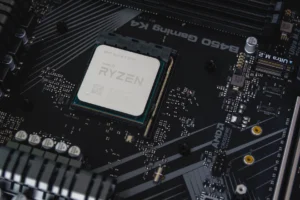CPUs are usually gold because gold is a great thermal conductor, so it conducts heat away from the CPU really fast. This prevents the chip from overheating, which could cause it to fail.
They are called CPU fan gold pins. The pins are gold-plated because the CPU gets extremely hot. When the CPU heats up, the copper wire pins tend to degrade. Gold will not degrade even when heated at high temperatures.
Why are CPU pins gold?
- Gold is a highly efficient conductor. A tiny amount of current can be carried by gold. This is why CPU pins are made of gold.
- Their corrosion resistance makes them ideal. As a result, they are not affected by atmospheric conditions. Gold is corrosion-resistant among other metals such as iron, copper, and steel.
- Nickel and cobalt alloys increase the durability (resistance) of gold. Alloying gold with other materials increases its strength.
- Their main purpose is to increase the conductivity of currents (digital information) in connectors and contacts.
- The atmosphere does not easily oxidize gold. Therefore, it is mostly used.
- The electrical resistivity of gold is the lowest.
- The inactive nature of gold is due to its chemical composition. As such, it cannot be affected chemically.
Things to know about CPU pins?
CPU Pins are used to connect the CPU to other peripheral devices, CPU pins functions are so many, including the CPU’s physical functions, power function, and temperature control function. CPU pins are divided into internal CPU pins and external CPU pins. Internal CPU pins are very complicated, generally, manufacturers will use the internal CPU pins to connect the CPU to internal components.
External CPU pins are used to communicate with the system bus, these pins are also called peripheral CPU pins. The CPU cannot operate without the peripheral CPU pins, the CPU cannot operate without the internal CPU pins, and the CPU cannot operate without the CPU power supply pins.
Commonly asked questions
How much gold is in a CPU pin?
The amount of gold in a CPU pin can vary depending on the manufacturer and the specific type of CPU. However, it is generally a small amount. Gold is often used as a plating for connectors and other small components because it is an excellent conductor and is resistant to corrosion. The thickness of the gold plating on a CPU pin is usually measured in microns (1 micron = 0.001 mm). A typical thickness for gold plating on CPU pins is around 3-5 microns, which is less than 0.0002 inches.
Do all CPUs have gold pins?
Not all CPUs have gold pins. Some CPUs use other types of metals for their pins, such as copper or tin. The choice of metal for CPU pins is determined by a variety of factors, including cost, conductivity, and durability. Gold is a more expensive option than other metals, but it offers good conductivity and resistance to corrosion, which can extend the life of the CPU and improve its performance. While gold pins are more common in high-end CPUs, not all CPUs have gold pins.
How to recover gold from CPUs?
Recovering gold from CPUs (Central Processing Units) is a process that involves several steps. The general idea is to remove the gold-plated components from the CPUs and then dissolve them in a chemical solution to separate the gold. Here are the general steps to recover gold from CPUs:
- Crush the CPUs: The first step is to crush the CPUs into small pieces. This can be done with a hammer or a specialized CPU-crushing machine.
- Remove the components: Next, use a pair of tweezers or a magnet to remove any non-gold components, such as plastic, aluminum, or steel.
- Dissolve the gold: The gold-plated components can then be dissolved in a chemical solution of nitric acid and hydrochloric acid. This process is called “leaching” and it will separate the gold from the other metals.
- Purify the gold: After the gold has been dissolved, it will need to be purified. This can be done by adding a reducing agent like sodium metabisulfite to the solution. The purified gold will then be in the form of a yellow powder.
- Recovery of gold: The last step is to recover the gold from the solution. This can be done by using a process called “electrolysis” or by using a method called “precipitation” where the gold can be recovered by adding a chemical reagent that causes the gold to precipitate out of the solution.
What part of the computer has the most gold?
The part of a computer that contains the most gold is typically the central processing unit (CPU) or the integrated circuits (ICs) found on motherboards and other circuit boards. These components often contain small amounts of gold in the connectors and other parts, such as the pins of the CPU. The gold is used in these components because it is an excellent conductor and is resistant to corrosion.
Another part of a computer that can contain gold is the connectors and other parts of the graphics processing unit (GPU).
Please note that the amount of gold in a computer can vary depending on the manufacturer and the specific model, and that the recovery of gold from electronic waste is illegal in some places without the proper permits and certifications.


![Why CPU is Considered the Brain of the Computer [Explained!] Why CPU is Considered the Brain of the Computer [Explained!]](https://thebestcpu.com/wp-content/uploads/2023/02/brian-kostiuk-S4jSvcHYcOs-unsplash-300x200.jpg)

![Difference Between CPU and GPU Cores Explained [Complete Guide] Difference Between CPU and GPU Cores Explained [Complete Guide]](https://thebestcpu.com/wp-content/uploads/2023/02/vishnu-mohanan-yQpAaMsQzYE-unsplash-300x212.jpg)